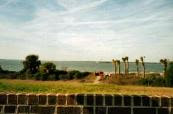 |
| Fort Moultrie, South Carolina |
It was a move, in Anderson's words, meant to "prevent the effusion in blood." In reality, it would lead to the outbreak of the bloodiest war in American history.
Fort Moultrie, located on Sullivan's Island across from Charleston, had long been the primary post for U.S. troops maintaining and garrisoning the forts that guarded the South Carolina harbor. Soldiers from William Tecumseh Sherman to Edgar Allen Poe had been stationed there and during the 1830s it had served as the prison for the famed Seminole warrior Osceola. His grave, in fact, can still be seen just outside the walls of the old brick fort.
 |
| 1860 Sketch of Evacuation of Fort Moultrie |
The author of a textbook on field artillery tactics, Anderson knew he could not hope to hold Fort Moultrie against any determined assault by South Carolina militia. The fort had been designed to sweep the channel of the harbor and its land defenses were minimal. If he hoped to maintain the U.S. presence in Charleston Harbor, his one option was to move his men across the channel to Fort Sumter.
 |
| Fort Sumter in distance from Fort Moultrie |
Led by Anderson in person, the bulk of his force went over to Fort Sumter in boats on the night of December 26, 1860. Left behind were twelve men and a surgeon, commanded by Captain J.G. Foster of the engineers, who were ordered to spike the heavy guns in Fort Moultrie and destroy their carriages. This work was accomplished during the night of the 26th and the fort's flagstaff was also cut down.
To learn more about Fort Moultrie, now a national park area and open to the public daily, please visit www.exploresouthernhistory.com/SCMoultrie1.
No comments:
Post a Comment